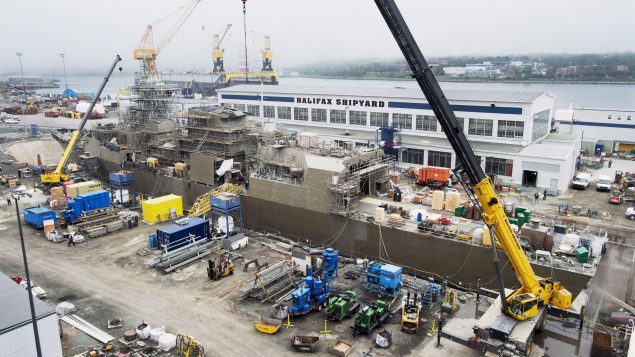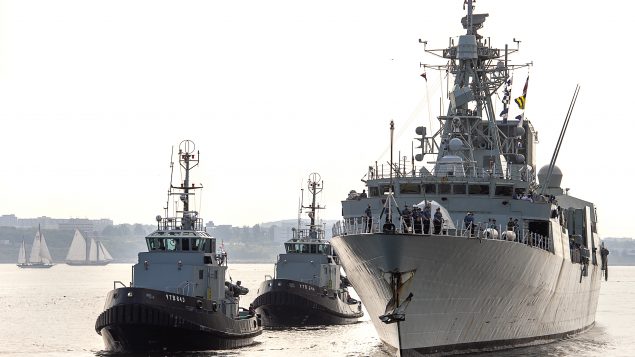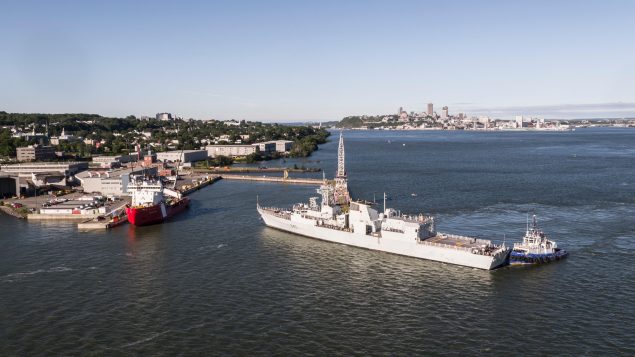The Davie shipyard announced Tuesday the official launch of a long-term naval maintenance and upgrade program designed to keep Canada’s fleet of 12 frigates operational until a new generation of warships replaces them in the early 2040s.
Davie welcomed HMCS St. John’s, the first frigate to undergo refits, at its newly refurbished drydock facilities in Lévis, Quebec.
Davie is one of the three Canadian shipyards participating in the $1.5-billion maintenance and upgrade program announced by the federal government last year.
Davie, Seaspan Victoria Shipyards in British Columbia and Irving Shipbuilding in Nova Scotia were each awarded a $500-million contract for maintenance work on the country’s fleet of Halifax-class frigates.
These initial contracts guarantee a minimum of three frigates for each shipyard. These contracts are expected to result in up to 400 direct jobs at each shipyard, as well hundreds of jobs in supporting industries across Canada, according to the federal government.
Jeff Collins, a Fellow with the Canadian Global Affairs Institute and a researcher on Canadian defence procurement, said these refits are designed to ensure that the Royal Canadian Navy (RCN) maintains a combat capable surface fleet until the 2040s, when the new Canadian Surface Combatants – to be built by Irving in Halifax – enter into service.
“The Halifax-class are now arguably past the mid-life point of their operational lives, especially when looking at those initial ships that rolled out in the early 1990s,” Collins said.
“As we know from the Iroquois class destroyers and original Protecteur class replenishment ships, the older the ships the higher the maintenance costs will be.”

A Navy ship undergoes a mid-life refit at the Irving Shipbuilding facility in Halifax on July 3, 2014. Halifax-based Irving Shipbuilding Inc., has been awarded a $500 million contract by the federal government to carry out maintenance work for the Royal Canadian Navy. (Andrew Vaughan/THE CANADIAN PRESS)
Docking maintenance work periods are critical to ensure the RCN has at least eight of its 12 patrol frigates ready for deployment at all times, Davie officials said Tuesday.
“This contract is different from the $4.3 billion modernization and frigate life extension program that took place in Irving and Seaspan between 2010-2018,” Collins said.
The Halifax-class Modernization/Frigate Life Extension (HCM/FELEX) program saw the replacement and updating of combat and operational equipment, Collins said.
The Canadian frigates, which were commissioned between 1992 and 1996, also got a new sea-to-land strike missile capability, something the warships did not have initially, he said.
The new strike capability was added based on operational experiences of the RCN and other allied navies, particularly after the 2011 Libya campaign, Collins said.

HMCS Ville de Quebec sails up the Halifax harbour in this Sept. 6, 2005 file photo. (Andrew Vaughan/THE CANADIAN PRESS)
Timothy Choi, a maritime strategy expert at the University of Calgary’s Centre for Military, Security and Strategic Studies, said that while the life extension program focused on the weapons and certain electronic systems, they left the more mundane hull, mechanical, and engineering improvements mostly untouched.
“That’s what these latest batch of refits will focus on, though some combat systems improvements will also be carried out such as the Naval Remote Weapon System,” Choi said.
The deal is another major win for Davie shipyard, which bills itself as “Canada’s largest, longest-established and highest capacity shipbuilder.”
Three of Canada’s 12 frigates – HMCS Ville de Quebec, HMCS Regina and HMCS Calgary – were built at Davie in the 1990s.
However, Davie was left out of Canada’s massive naval procurement program in 2011 because it was suffering from financial troubles at the time.
But it has since advocated to be allowed to participate in the wider program.

HMCS Fredericton, a Halifax-class Canadian frigate, returns to its home port of Halifax on Tuesday, July 28, 2020 after completing a six-month deployment in the Mediterranean Sea. HMCS Oriole, left, and Bluenose II, centre, escorted the warship up the harbour. (Andrew Vaughan/THE CANADIAN PRESS)
Collins said one of the unanswered questions for him is what happens if work on the new Canadian Surface Combatants is delayed and the Halifax-class frigates require another round of comprehensive modifications to their combat and operating systems similar to work carried out in 2010-2018.
“Such work is very complex, involves multiple prime contractors and a careful dance of rotating ships in and out to ensure RCN operational capability,” Collins said.
Irving and Seaspan have the institutional knowledge and relationships in place to undertake this but both, especially Irving, will be busy with completing their existing orders for the navy and the Canadian Coast Guard, Collins said.
“There will likely be a premium to be paid to move that work to Davie and in a time of massive government spending and, I am sure, later, deficit reductions, is that a premium a government of any stripe will pay?” Collins said.
The federal government says it is investing more than $7.5 billion in the 12 Halifax-class frigates to provide necessary ongoing maintenance until they are retired in the early 2040s.







For reasons beyond our control, and for an undetermined period of time, our comment section is now closed. However, our social networks remain open to your contributions.